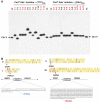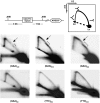Chromosome fragility at GAA tracts in yeast depends on repeat orientation and requires mismatch repair
- PMID: 18833189
- PMCID: PMC2580784
- DOI: 10.1038/emboj.2008.205
Chromosome fragility at GAA tracts in yeast depends on repeat orientation and requires mismatch repair
Abstract
Expansion of triplex-forming GAA/TTC repeats in the first intron of FXN gene results in Friedreich's ataxia. Besides FXN, there are a number of other polymorphic GAA/TTC loci in the human genome where the size variations thus far have been considered to be a neutral event. Using yeast as a model system, we demonstrate that expanded GAA/TTC repeats represent a threat to eukaryotic genome integrity by triggering double-strand breaks and gross chromosomal rearrangements. The fragility potential strongly depends on the length of the tracts and orientation of the repeats relative to the replication origin, which correlates with their propensity to adopt triplex structure and to block replication progression. We show that fragility is mediated by mismatch repair machinery and requires the MutSbeta and endonuclease activity of MutLalpha. We suggest that the mechanism of GAA/TTC-induced chromosomal aberrations defined in yeast can also operate in human carriers with expanded tracts.
Figures






Similar articles
-
Genome-wide screen identifies pathways that govern GAA/TTC repeat fragility and expansions in dividing and nondividing yeast cells.Mol Cell. 2012 Oct 26;48(2):254-65. doi: 10.1016/j.molcel.2012.08.002. Epub 2012 Sep 6. Mol Cell. 2012. PMID: 22959270 Free PMC article.
-
Replication-independent instability of Friedreich's ataxia GAA repeats during chronological aging.Proc Natl Acad Sci U S A. 2021 Feb 2;118(5):e2013080118. doi: 10.1073/pnas.2013080118. Proc Natl Acad Sci U S A. 2021. PMID: 33495349 Free PMC article.
-
Large-scale contractions of Friedreich's ataxia GAA repeats in yeast occur during DNA replication due to their triplex-forming ability.Proc Natl Acad Sci U S A. 2020 Jan 21;117(3):1628-1637. doi: 10.1073/pnas.1913416117. Epub 2020 Jan 7. Proc Natl Acad Sci U S A. 2020. PMID: 31911468 Free PMC article.
-
Chromosome fragility: molecular mechanisms and cellular consequences.Front Biosci. 2007 Sep 1;12:4911-24. doi: 10.2741/2437. Front Biosci. 2007. PMID: 17569619 Review.
-
Advances in mechanisms of genetic instability related to hereditary neurological diseases.Nucleic Acids Res. 2005 Jul 8;33(12):3785-98. doi: 10.1093/nar/gki697. Print 2005. Nucleic Acids Res. 2005. PMID: 16006624 Free PMC article. Review.
Cited by
-
The mismatch repair system protects against intergenerational GAA repeat instability in a Friedreich ataxia mouse model.Neurobiol Dis. 2012 Apr;46(1):165-71. doi: 10.1016/j.nbd.2012.01.002. Epub 2012 Jan 20. Neurobiol Dis. 2012. PMID: 22289650 Free PMC article.
-
Genetic Screens to Study GAA/TTC and Inverted Repeat Instability in Saccharomyces cerevisiae.Methods Mol Biol. 2020;2056:103-112. doi: 10.1007/978-1-4939-9784-8_6. Methods Mol Biol. 2020. PMID: 31586343 Free PMC article.
-
Friedreich's ataxia (GAA)n•(TTC)n repeats strongly stimulate mitotic crossovers in Saccharomyces cerevisae.PLoS Genet. 2011 Jan 13;7(1):e1001270. doi: 10.1371/journal.pgen.1001270. PLoS Genet. 2011. PMID: 21249181 Free PMC article.
-
Pms2 suppresses large expansions of the (GAA·TTC)n sequence in neuronal tissues.PLoS One. 2012;7(10):e47085. doi: 10.1371/journal.pone.0047085. Epub 2012 Oct 11. PLoS One. 2012. PMID: 23071719 Free PMC article.
-
The balancing act of DNA repeat expansions.Curr Opin Genet Dev. 2013 Jun;23(3):280-8. doi: 10.1016/j.gde.2013.04.009. Epub 2013 May 29. Curr Opin Genet Dev. 2013. PMID: 23725800 Free PMC article. Review.
References
-
- Al-Mahdawi S, Pinto RM, Ruddle P, Carroll C, Webster Z, Pook M (2004) GAA repeat instability in Friedreich ataxia YAC transgenic mice. Genomics 84: 301–310 - PubMed
-
- Bignami M, Casorelli I, Karran P (2003) Mismatch repair and response to DNA-damaging antitumour therapies. Eur J Cancer 39: 2142–2149 - PubMed
-
- Bissler JJ (2007) Triplex DNA and human disease. Front Biosci 12: 4536–4546 - PubMed
Publication types
MeSH terms
Grants and funding
LinkOut - more resources
Full Text Sources
Molecular Biology Databases
Miscellaneous

